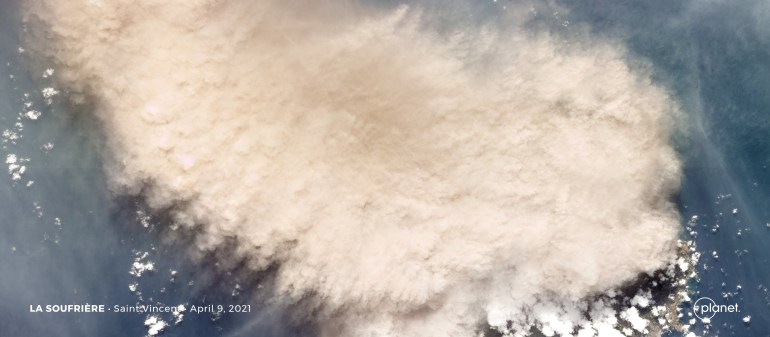Saint Vincent awaits more volcanic eruptions as help offered
Caribbean nations have offered help by either shipping emergency supplies or temporarily opening their borders.

Heavy ashfall rained down on parts of the eastern Caribbean island of Saint Vincent and a strong sulphur smell enveloped communities a day after a powerful eruption of the La Soufriere volcano uprooted the lives of thousands of people who evacuated their homes under government orders.
Caribbean nations including Antigua and Guyana on Saturday offered help by either shipping emergency supplies or temporarily opening their borders to the roughly 16,000 evacuees fleeing ash-covered communities with as many personal belongings as they could stuff into suitcases and backpacks.
Keep reading
list of 3 itemsSaint Vincent to evacuate thousands after volcano threat
Volcano on Caribbean’s St Vincent erupts, spews ash and smoke
The volcano, which last had a sizeable eruption in 1979, kept rumbling and experts warned that the explosive eruptions could continue for days or weeks.
A previous eruption in 1902 killed some 1,600 people.
“The first bang is not necessarily the biggest bang this volcano will give,” Richard Robertson, a geologist with the University of the West Indies Seismic Research Center, said during a news conference.
Prime Minister Ralph Gonsalves asked people to remain calm, have patience and keep protecting themselves from the coronavirus as he celebrated that no deaths or injuries were reported after the eruption in the northern tip of Saint Vincent, part of an island chain that includes the Grenadines and is home to more than 100,000 people.
“Agriculture will be badly affected, and we may have some loss of animals, and we will have to do repairs to houses, but if we have life, and we have strength, we will build it back better, stronger, together,” he said in an interview with NBC Radio, a local station.
Gonsalves has said that, depending on the damage caused by the explosion, it could take up to four months for life to return to normal.
As of Saturday, some 3,200 people were staying in 78 government shelters while four empty cruise ships floated nearby, waiting to take other evacuees to nearby islands.
Those staying in shelters were tested for COVID-19, and anyone testing positive would be taken to an isolation centre.

The first explosion occurred on Friday morning, a day after the government ordered mandatory evacuations based on warnings from scientists who noted a type of seismic activity before dawn on Thursday that meant magma was on the move close to the surface.
An ash column burst more than 7km (23,000 feet) into the sky, with lightning crackling through the still-towering cloud late on Friday.
The ash forced the cancellation of several flights and poor visibility limited evacuations in some areas.
Officials warned that Barbados, St Lucia and Grenada could see light ash fall as the 1,220 metre (4,000 feet) volcano continued to rumble. Most of the ash was expected to head northeast into the Atlantic Ocean.
La Soufriere previously had an effusive eruption in December, prompting experts from around the region to fly in and analyse the formation of a new volcanic dome and changes to its crater lake, among other things.
The eastern Caribbean has 19 live volcanoes, including two underwater near the island of Grenada. One of those, Kick ’Em Jenny, has been active in recent years.
But the most active volcano of all is Soufriere Hills in Montserrat. It has erupted continuously since 1995, razing the capital of Plymouth and killing at least 19 people in 1997.